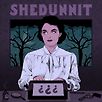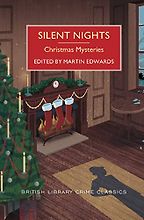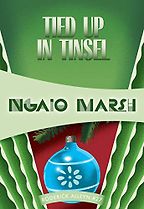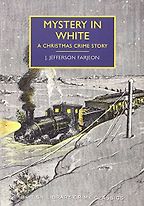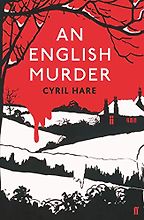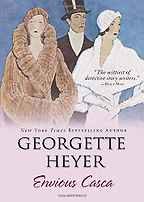You are the creator of the Shedunnit podcast, where you’ve been running an advent calendar highlighting the best festive mystery books in the run up to Christmas. Can you tell us a bit more about Shedunnit, and what listeners can expect?
I describe it as “the podcast that unravels the mysteries behind classic detective fiction” and that’s fairly accurate. The episodes are fortnightly and 20-ish minutes long, with each one comprising an audio essay that covers an aspect of detective fiction from the 1920s and 1930s — the books of Agatha Christie, Dorothy L. Sayers and Ngaio Marsh make regular appearances.
Three recent favourite episodes: ‘The Butler Did It,’ about how murder mysteries incorporated the so called ‘servant problem’ of the 1920s; ‘Lifelong Fan,’ in which I talked to the feminist New Zealand playwright Renée who read her first whodunnit in the early 1930s and is still reading them today; and ‘A Christie for Christmas,’ which is about how our reading habits in 2020 mirror the post 1918 flu pandemic boom in crime fiction of a century ago.
When we spoke ahead of this interview, you described these books as dating from the ‘golden age’ of crime fiction. Could you expand on that?
The golden age of the detective fiction is usually defined as the period between the First and Second World Wars, when authors like Agatha Christie, John Dickson Carr, Ngaio Marsh, Dorothy L. Sayers, Anthony Berkeley, Josephine Tey, Freeman Wills Crofts and Margery Allingham were all publishing whodunnits and the genre was enjoying great popularity. Although all of these writers had distinctive styles and approaches, they all – mostly! – observed certain conventions that identify them as of this tradition and period.
In particular, they abided by the doctrine of ‘fair play,’ which dictates that the author must place all of the clues necessary to solve the mystery before the reader, rather than revealing a hitherto unmentioned suspect right at the end, for example. The detective novelist and Catholic priest Ronald Knox famously codified these rules in his ‘decalogue’ from 1929, a text that is partly poking fun at his colleagues but is also a decent summation of the aims of crime novelists at this time. There’s a theory that the tremendous popularity of this type of book between 1918 and 1939 has something to do with the collective trauma experienced during the First World War and the flu pandemic — people craved the simple pleasure and ordered world of a good whodunnit.
Let’s talk about your first Christmas mystery book recommendation. This is a short story by Dorothy L Sayers, ‘The Necklace of Pearls,’ which can be found in the Silent Nights anthology published by the British Library. What’s it about? What do you like about it?
This is a classic ‘country house at Christmas’ short story, first published in 1931. Sayers’s regular sleuth Lord Peter Wimsey is spending the festive period at a house party hosted by a rich and genial old man who loves to have his guests play classic parlour games like Hunt the Slipper and Sardines. During a game of Animal, Vegetable or Mineral? he notices that his daughter’s priceless pearl necklace has disappeared from the side table where she had put it for safety. A search quickly reveals that none of the guests have pocketed it and it’s not anywhere in the house, yet nobody has left the property nor been alone for more than a few seconds. It’s up to Wimsey to track it down, and while I don’t want to spoil what is really a very clever ending, suffice to say that it’s a very appropriately seasonal solution.
Next you want to recommend Ngaio Marsh’s Tied Up in Tinsel. Why so?
Tied Up In Tinsel is actually one of Marsh’s later novels. She published her first in 1934 during the golden age but she then lived into the 1980s and kept writing in a similar style throughout her life. This one is from 1972 and sees her regular Scotland Yard sleuth, Roderick Alleyn, drawn into a country house murder mystery after someone disappears from the house party. Just to add extra spice to the case, many of the servants at this house are convicted murderers who have served their time and been released — altruism or cunning scheme? The reader must decide!
Fun. Ngaio Marsh is considered one of the ‘queens of crime’, alongside with Agatha Christie. What else might you recommend from her oeuvre?
Marsh was a huge theatre enthusiast and a celebrated director of amateur and university Shakespeare productions in her native New Zealand. She brought some of this dramatic expertise into her detective fiction, with plenty of her novels featuring actors or plays in some way, and I think she did some of her best writing about this setting. My particular favourites are Enter a Murderer, in which an actor is shot dead on stage during a performance by what was supposed to be a dummy gun, and Overture to Death, which is about an extraordinary murder among the actors in a parish play in rural Dorset.
J Jefferson Farjeon’s Mystery in White: A Christmas Crime Story is up next. It looks very festive from the cover! What can readers expect of this book?
This is a novel that was originally published in 1938 and has recently been brought back into print by the British Library’s Crime Classics imprint, becoming an unexpected bestseller when it was rereleased in 2014. I love it because of the opening setup: a collection of strangers are travelling home in the same train carriage on Christmas Eve when the train gets stuck in a snowdrift. They are forced to pool their resources and trek out into the snow to seek shelter for the night. The group finds a nearby house with the door ajar where a fire is burning, tea has been laid on the table as if guests are expected, but there’s nobody to be found. A quite creepy mystery unfolds from there!
Great concept. Up next we have An English Murder by Cyril Hare. It originated as a radio play, I believe, and is known as ‘the Christmas Murder’. Tell us about it.
This is another one set at a country house over Christmas, a scenario beloved of mystery writers, because it provides a conveniently limited circle of suspects and a nicely festive atmosphere.
Get the weekly Five Books newsletter
However, this one was published in 1951 and tackles the ways in which British society has been changed by the Second World War. Hare takes on aristocratic antisemitism and the post war economic slump as well as delivering an entertaining murder mystery.
Finally we have Envious Casca by Georgette Heyer. Another classic country house mystery, set at Christmas. Why have you recommended this book in particular?
This is a true classic of the golden age, first published in 1941, with the usual country house setting and a festive house party suddenly turned tragic by a murder. Heyer is better known today for her historical and romantic novels, but starting in 1932 she published twelve detective novels that really deserve to be more widely read. It’s also been republished under the title A Christmas Party in case the “envious Casca” quotation from Shakespeare’s Julius Caesar is off-putting to the contemporary reader.
I was, I admit, surprised to find there are so many mysteries set at Christmas time. Why do you think that is?
Lots of reasons! Christmas is a convenient and plausible reason for a novelist to gather characters together in one place, including those who don’t like each other very much but feel some kind of duty to be present for the celebrations. The festive season can also escalate existing tensions, or cause hidden secrets to be revealed, which can result in a tragedy. A house party, especially in a rural area, isolates and confines suspects in one place and helpfully limits the scope of a detective’s investigation (a book where theoretically anybody in the world can have done the crime is no fun).
Yes, I’ve seen the term ‘closed circle mystery’ used to describe books like this.
Snow, too, is very useful for capturing or concealing footprints; I once made a whole podcast episode about this. The contrast between the “comfort and joy” of the Christmas season and the darkness of a sudden murder is a good impetus for a plot, too. Finally, I think there’s something in the idea that midwinter is a time for gathering around the fire and listening to scary stories — and what could be more scary than realising that there’s a murderer on your Christmas guestlist?
Interview by Cal Flyn, Deputy Editor
December 22, 2020. Updated: July 29, 2023
Five Books aims to keep its book recommendations and interviews up to date. If you are the interviewee and would like to update your choice of books (or even just what you say about them) please email us at [email protected]
Five Books interviews are expensive to produce. If you've enjoyed this interview, please support us by donating a small amount.

